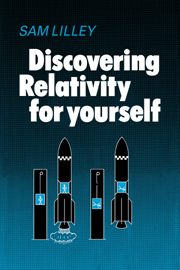Book contents
- Frontmatter
- Contents
- Preface
- Introduction
- 1 Getting started
- 2 Rough and ready Relativity
- 3 The dilation of time
- 4 Three clocks and a pair of twins
- 5 Starting again
- 6 Space–time diagrams
- 7 Time and distance ‘over there’
- 8 Co-ordinate systems
- 9 Combining speeds
- 10 Causality and the speed of light
- 11 The nature of spacetime
- 12 Interval
- 13 Old friends revisited
- 14 The scales of the spacetime diagram
- 15 The radar point of view
- 16 Relations between the radar and time–distance systems
- 17 Constant acceleration
- 18 Dynamics–mass, momentum, force
- 19 The mass–energy relation
- 20 The effect of acceleration on time measurement
- 21 Time as experienced by a constant acceleration traveller
- 22 Time and distance measurements of a constant acceleration observer
- 23 The Principle of Equivalence
- 24 The metric
- 25 Introducing geodesies
- 26 How to find ordinary geodesies
- 27 Inverse square law gravity
- 28 Curved spacetime
- 29 The metric around the Sun
- 30 Light and gravity
- 31 The scandal about Mercury
- 32 How Einstein did it
- 33 A few conclusions
- Index
23 - The Principle of Equivalence
Published online by Cambridge University Press: 15 March 2010
- Frontmatter
- Contents
- Preface
- Introduction
- 1 Getting started
- 2 Rough and ready Relativity
- 3 The dilation of time
- 4 Three clocks and a pair of twins
- 5 Starting again
- 6 Space–time diagrams
- 7 Time and distance ‘over there’
- 8 Co-ordinate systems
- 9 Combining speeds
- 10 Causality and the speed of light
- 11 The nature of spacetime
- 12 Interval
- 13 Old friends revisited
- 14 The scales of the spacetime diagram
- 15 The radar point of view
- 16 Relations between the radar and time–distance systems
- 17 Constant acceleration
- 18 Dynamics–mass, momentum, force
- 19 The mass–energy relation
- 20 The effect of acceleration on time measurement
- 21 Time as experienced by a constant acceleration traveller
- 22 Time and distance measurements of a constant acceleration observer
- 23 The Principle of Equivalence
- 24 The metric
- 25 Introducing geodesies
- 26 How to find ordinary geodesies
- 27 Inverse square law gravity
- 28 Curved spacetime
- 29 The metric around the Sun
- 30 Light and gravity
- 31 The scandal about Mercury
- 32 How Einstein did it
- 33 A few conclusions
- Index
Summary
Suppose that W–the observer of the previous chapter moving with constant acceleration – watches any inertial observers that may be around. How will their motion appear to him?
Think, for example, about several cars moving at various steady speeds along a straight road, and about what their motion would look like when observed from another car that has constant acceleration. I think you'll conclude that the distance between W and any inertial observer E is changing in a constantly accelerated manner, and that therefore
If W regards himself as stationary, he must think that all inertial observers are moving with constant acceleration f (in the opposite direction to that of his own constant acceleration).
(A possible worry: maybe it won't work out quite like that–because E and W don't agree about times and distances. Actually if you do the calculations, based on our Chapter 22 near-equations, you discover that the statement is only strictly true if E is near to W and moving slowly relatively to him–both conditions to be interpreted in an asaccurately-as-we-wish sense. But that's good enough for us, since we'll only want to use this proposition in nearby, slow-speed conditions.)
Maybe you protested that W knows (by the particle test) that he is accelerated, and so he can't regard himself as stationary. But do you know of any circumstances in which an observer's test particle runs away and yet he insists that he's at rest?
Your test particle accelerates rapidly away from you (cf. §5.4). Yet you have no difficulty in thinking of yourself as stationary.
- Type
- Chapter
- Information
- Discovering Relativity for Yourself , pp. 267 - 275Publisher: Cambridge University PressPrint publication year: 1981



